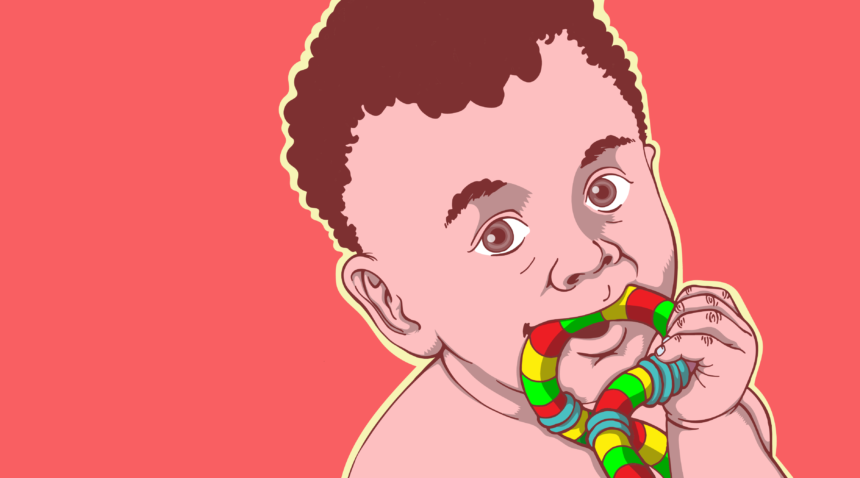If you’re reading this, you don’t remember what teething feels like—and that’s probably a good thing. Teething is the process of a baby’s teeth breaking through the gums, and it usually happens between 4 and 30 months of age. Teething babies are often uncomfortable and fussy as they go through this long process.
“It can be really painful, and sometimes they can’t sleep or have trouble eating,” says UNC pediatrician Ricardo Baler, MD. “It can be upsetting, but it’s a normal and important part of development, and both baby and parents will make it through.”
You can ease the journey for the whole family by following these five tips.
1. Know the typical teething timeline.
Babies usually get their first two teeth between months 4 and 10, and they’re often the front bottom teeth.
Teething comes and goes, but you’ll continue to see new teeth erupt in your baby’s mouth until he or she is about 2½. Teeth often come in at the pace of about one a month, with teeth in the front and center coming in before the sides and back, but the timing and pattern vary by child.
In rare cases, a baby can be born with teeth. Usually, these so-called natal teeth are removed to prevent injury or the risk of the baby swallowing one, Dr. Baler says.
2. Keep an eye on symptoms that might indicate something else.
Symptoms of teething include pain, a low-grade fever (lower than 100.4 degrees), irritability, drooling, inflammation and redness in the gums.
But teething does not cause high fevers (100.4 degrees or more), nasal congestion, a runny nose, vomiting or diarrhea. If your child has any of those symptoms, it’s probably a virus or bacterial infection, Dr. Baler says.
“A child in the first 30 months of life is going to have, on average, nine colds a year, back to back, and they get diarrhea and fevers, especially if they go to day care or are around other children,” Dr. Baler says. “This is normal and part of building the immune system, but it isn’t because they’re teething.”
Viruses and bacterial infections are common in babies but can be serious, so if your child has these symptoms, call your child’s doctor.
3. Soothe with teethers but not topical gels.
Teething babies can get relief by biting on plastic or rubber teethers that have been put in the refrigerator. Don’t put teethers in the freezer, as they will become too hard and can damage your baby’s mouth. Choose a teether that is one piece and too large to pose a choking hazard; the American Academy of Pediatrics warns against teething necklaces and beads for this reason.
Gently massage your baby’s gums with clean fingers or a cool washcloth to help ease discomfort. If your baby appears to be in pain, you can give him or her Infants’ Tylenol, Dr. Baler says.
Steer clear of all numbing gels or creams. Many contain benzocaine, a local anesthetic that has been linked to a potentially life-threatening condition that causes seizures. Plus, topical products are unlikely to work in a baby’s mouth, where they will be quickly washed away by saliva and swallowed.
4. If there’s a tooth there, brush it.
It might seem silly, but if your baby has a tooth, brush it daily with a baby or toddler toothbrush (look for a very small brush head and soft bristles), Dr. Baler says.
“We encourage parents to start brushing their children’s teeth when they are very young,” he says. “Kids get used to it early, and they’ll do it forever.”
Every child should see a dentist by age 2, Dr. Baler adds, but ideally even before then—six months after the eruption of the first tooth is best. Babies and toddlers should receive a fluoride treatment every six months to help prevent tooth decay.
5. Call the doctor when you need help.
Just because teething is normal doesn’t mean it’s easy. Parents should feel free to call their child’s doctor for help, Dr. Baler says.
Some situations might indicate an underlying problem that should be brought to a doctor’s attention. These include no teeth by age 15 months, several teeth erupting but only on one side of the mouth, and teeth falling out before age 6.
Whether or not there’s a potential problem, parents should see their child’s doctor as an ally in the teething process, Dr. Baler says.
“They can call any time they have concerns, always,” he says.
Call your child’s doctor if you have concerns about teething. If you need a doctor, find one near you.

